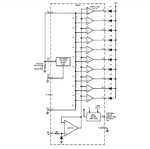SparkyChem
Member level 3
- Joined
- Apr 22, 2010
- Messages
- 57
- Helped
- 0
- Reputation
- 0
- Reaction score
- 0
- Trophy points
- 1,286
- Location
- Lima, Peru
- Activity points
- 2,084
As the title implies I'm trying to make LM3914 to work as an exclamation point and alarm flasher. There is already a set up how to achieve both individually in the documentation from the LED bar driver. However I am confused at how to make it work for my needs based the parameters explained below.
My requirement needs to work with an input going from -5V to +5V, indicating over range for both. i.e lets say if the input is -6V, the bar indicator has to begin with the "center at zero" and to flash as indicate over range and the same for +5V thus if +6V turning on the leds from zero and flashing to indicate again over range. So How can I build an indicator with those parameters? :thinker:
I think it has something to do with appending these recommended circuits but I don't know how to do that or if that is the best way to go.

In the documentation referring to exclamation point there is a 3V pulse going in the input through the base of the transistor and it recommends that very specific voltage. However I don't have it available. Can 5V be used instead?. What modification should be made on that part?
I tried to inspect all sources for trying to answer my question or show my progress if this can be done, but I couldn't find anything conclusive. Therefore can somebody with more experience than me help me with this matter?.
Btw please don't say you can do that with a microcontroller or some other IC, I'm aware that there are other methods but that is not what I'm looking for as my needs require specific use of the LM3914.
My requirement needs to work with an input going from -5V to +5V, indicating over range for both. i.e lets say if the input is -6V, the bar indicator has to begin with the "center at zero" and to flash as indicate over range and the same for +5V thus if +6V turning on the leds from zero and flashing to indicate again over range. So How can I build an indicator with those parameters? :thinker:
I think it has something to do with appending these recommended circuits but I don't know how to do that or if that is the best way to go.

In the documentation referring to exclamation point there is a 3V pulse going in the input through the base of the transistor and it recommends that very specific voltage. However I don't have it available. Can 5V be used instead?. What modification should be made on that part?
I tried to inspect all sources for trying to answer my question or show my progress if this can be done, but I couldn't find anything conclusive. Therefore can somebody with more experience than me help me with this matter?.
Btw please don't say you can do that with a microcontroller or some other IC, I'm aware that there are other methods but that is not what I'm looking for as my needs require specific use of the LM3914.

![fZI1TSL.png]](https://i.imgur.com/fZI1TSL.png])







